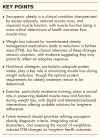Sarcopenic obesity and weight loss-induced muscle mass loss
- PMID: 40296814
- PMCID: PMC12147736
- DOI: 10.1097/MCO.0000000000001131
Sarcopenic obesity and weight loss-induced muscle mass loss
Abstract
Purpose of review: Sarcopenic obesity is a clinical condition characterized by the coexistence of excess adiposity and impaired muscle function, associated with heightened cardiometabolic risk and frailty. The emergence of new incretin-based obesity management medications (OMMs), which allow unprecedented weight loss, has raised concerns regarding weight loss-induced fat-free mass (FFM) reduction, including skeletal muscle mass (SMM). This review examines recent findings on the prevalence, diagnosis, and implications of sarcopenic obesity, explores the effects of weight-loss interventions on body composition and their impact on health, and discusses strategies to preserve muscle mass.
Recent findings: Weight loss induced by incretin-based OMMs results in a variable but significant reduction in FFM. The extent to which this loss affects SMM and function remains uncertain. Nutritional strategies, particularly adequate protein intake, and structured exercise interventions, especially resistance training, play a key role in mitigating FFM loss. Digital health interventions and telemedicine-based exercise programs offer promising approaches for maintaining muscle health during weight loss.
Summary: The clinical significance of FFM loss during weight reduction remains debated. Future research should refine sarcopenic obesity diagnostic criteria, assess the long-term impact of FFM/SMM reduction during intentional weight loss, and evaluate interventions that optimize body composition while preserving functional health.
Keywords: GLP-1 receptor agonists; fat-free mass; muscle strength; sarcopenic obesity; weight loss.
Copyright © 2025 The Author(s). Published by Wolters Kluwer Health, Inc.
Conflict of interest statement
Figures





Similar articles
-
Nutrition support whilst on glucagon-like peptide-1 based therapy. Is it necessary?Curr Opin Clin Nutr Metab Care. 2025 Jul 1;28(4):351-357. doi: 10.1097/MCO.0000000000001130. Epub 2025 May 2. Curr Opin Clin Nutr Metab Care. 2025. PMID: 40401903 Review.
-
The Etiology of Reduced Muscle Mass with Surgical and Pharmacological Weight Loss and the Identification of Potential Countermeasures.Nutrients. 2024 Dec 31;17(1):132. doi: 10.3390/nu17010132. Nutrients. 2024. PMID: 39796566 Free PMC article. Review.
-
Sarcopenic obesity: Time to meet the challenge.Clin Nutr. 2018 Dec;37(6 Pt A):1787-1793. doi: 10.1016/j.clnu.2018.04.018. Epub 2018 May 7. Clin Nutr. 2018. PMID: 29857921
-
Fat and fat-free mass as important determinants of body composition assessment in relation to sarcopenic obesity.Rocz Panstw Zakl Hig. 2023;74(1):59-69. doi: 10.32394/rpzh.2023.0243. Rocz Panstw Zakl Hig. 2023. PMID: 37010407
-
Land-based versus aquatic resistance therapeutic exercises for older women with sarcopenic obesity: study protocol for a randomised controlled trial.Trials. 2013 Sep 16;14:296. doi: 10.1186/1745-6215-14-296. Trials. 2013. PMID: 24041219 Free PMC article. Clinical Trial.
Cited by
-
Optimizing Body Composition During Weight Loss: The Role of Amino Acid Supplementation.Nutrients. 2025 Jun 13;17(12):2000. doi: 10.3390/nu17122000. Nutrients. 2025. PMID: 40573110 Free PMC article. Review.
References
-
- Neeland IJ, Linge J, Birkenfeld AL. Changes in lean body mass with glucagon-like peptide-1-based therapies and mitigation strategies. Diabetes Obes Metab 2024; 26: (Suppl 4): 16–27. - PubMed
-
- Conte C, Hall KD, Klein S. Is weight loss-induced muscle mass loss clinically relevant? JAMA 2024; 332:9–10. - PubMed
-
- Prado CM, Phillips SM, Gonzalez MC, Heymsfield SB. Muscle matters: the effects of medically induced weight loss on skeletal muscle. Lancet Diabetes Endocrinol 2024; 12:785–787. - PubMed
-
- Linge J, Birkenfeld AL, Neeland IJ. Muscle mass and glucagon-like peptide-1 receptor agonists: adaptive or maladaptive response to weight loss? Circulation 2024; 150:1288–1298. - PubMed
-
This analysis suggests that GLP-1 receptor agonists may induce adaptive changes in muscle mass, improving muscle quality and insulin sensitivity in individuals undergoing weight loss.
Publication types
MeSH terms
LinkOut - more resources
Full Text Sources
Medical
Research Materials

